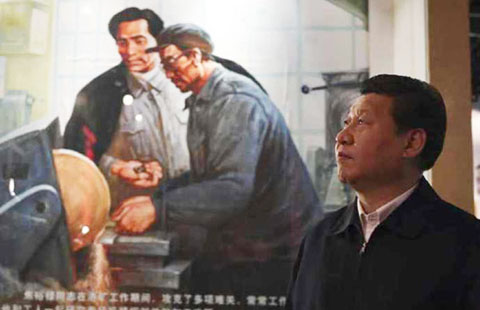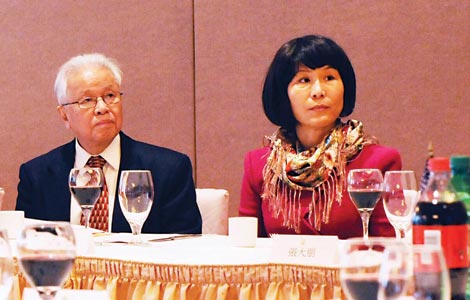Textiles fuel push for jobs in Xinjiang
Updated: 2014-03-19 01:39
By CUI JIA (China Daily)
|
||||||||
Plan to develop the industry also aims to focus on stability in region
The Xinjiang Uygur autonomous region plans to develop the textile industry vigorously this year to create more jobs and help maintain stability, according to local officials.
A plan has been drafted to expand the industry to raise employment capacity to 1 million people by 2020 from the current 200,000. More than 52 percent of China's commercial cotton is harvested in Xinjiang.
"Textiles is a labor-intensive industry with a long production chain. The best option is to create a large number of jobs in southern Xinjiang," said Liang Yong, deputy director of the region's Commission of Economy and Informatization.
A top leader has also said that developing labor-intensive industry should be given prominence because it could help to solve the employment situation in southern Xinjiang.
There is also the need to maintain social stability in Xinjiang, said Yu Zhengsheng, China's top political adviser.
He made the comments last week while attending a group discussion for the Xinjiang delegation during the top legislature's annual session.
Aniwar Imin, director of the Xinjiang Department of Human Resources and Social Security, said that boosting employment has been a priority in southern Xinjiang.
"Xinjiang should promote labor-intensive industries and encourage people to change their views about employment. Securing jobs could help to narrow the income gap and eliminate unstable factors in society," he said.
He added that the central government could also create more opportunities outside the region for people from different ethnic groups.
Maintaining social stability has been a priority in Xinjiang since President Xi Jinping presided over a meeting in December to hear reports from the region's top officials. Nur Bekri, chairman of the region, said last week that preventing and eliminating religious extremism has become an important task for Xinjiang as it strives to maintain long-term stability.
An increasing number of terrorist attacks occurred in Xinjiang in 2013 and police said most of the attackers had been brainwashed by religious extremism.
Xinjiang officials said jobless young people with little education are often drawn to those promoting extremism.
Gulistan Azez, deputy head of Yuepuhu, a township in the city of Kashgar, said, "High school graduates who are under 28 and unemployed are much more easily manipulated by religious extremism.
"To reduce such a possibility, we provide vocational training and assist them to find jobs. We have to help young people before they are targeted by religious extremism."
Under the plan, the city of Aksu in southern Xinjiang will be one of three future textile hubs.
In tandem with this, Kashgar city and Bachu, a county in Kashgar prefecture, along with Shayar, a county in Aksu, are among the sites chosen for seven industrial parks.
Merdan Mugeti, commissioner of Aksu prefecture, said textiles will become a pillar industry in the prefecture and will generate jobs.
Mutalif Wubuli, commissioner of Kashgar prefecture, said providing proper training is also important, adding, "The entry rate for senior high schools in Kashgar reached 73 percent in 2013 and the majority of the students went to vocational schools."
Zhang Chunxian, the region's Party chief, said: "Development is the key. The goal of maintaining healthy economic growth is to secure employment, especially for surplus labor in rural areas."
Zhang said per capita GDP in Xinjiang increased from $2,900 in 2009 to $6,710 in 2013.
Xinjiang has been organizing people, mostly Uygurs from rural areas, to work in factories elsewhere in China.
Rehangul Yimir, from southern Xinjiang's Kizilsu Kyrgyz autonomous prefecture, found work in a factory.
"I've been working at a textile factory in Zhejiang province with many others from my hometown. I hope we can eventually work closer to home," she said. "It's the long-term solution to solving the employment problem."

 Skyscrapers in E China resemble LV check pattern
Skyscrapers in E China resemble LV check pattern
 President Xi honors memory of devoted county Party chief
President Xi honors memory of devoted county Party chief
 More than just food
More than just food
 Miss world visits cancer children in Colombia
Miss world visits cancer children in Colombia
 Chinese paintings exhibited at Sotheby's
Chinese paintings exhibited at Sotheby's
 Jewish holiday of Purim celebrated in US
Jewish holiday of Purim celebrated in US
 Nurturing the art scholars of tomorrow
Nurturing the art scholars of tomorrow
 Chinese Americans will be awarded Ellis Island medals
Chinese Americans will be awarded Ellis Island medals
Most Viewed
Editor's Picks

|

|

|

|

|

|
Today's Top News
US first lady's visit expected for goodwill
New US envoy hits ground running
Tourists offered compensation for bad air days
Thai radar may have detected missing Malaysian jet
Chinese authorities upgrade food waste fight
Textiles creats for jobs in Xinjiang
First lady's China trip aimed at better ties
Ukraine rejects Crimea treaty
US Weekly

|

|





